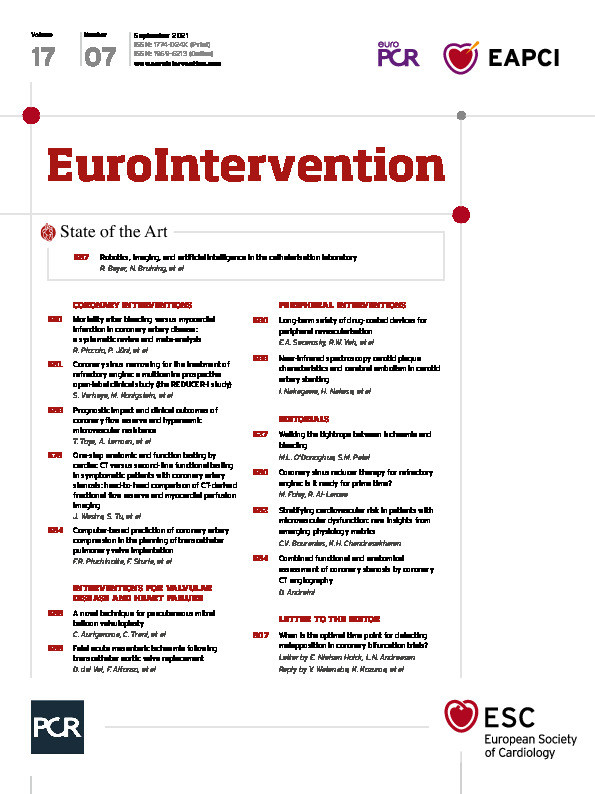We thank Dr Holck and colleagues1 for their interest regarding our paper2. We concur with the authors that our study had some limitations inherent to the study design.
Our study was the first prospective open-label randomised study to investigate whether the proximal optimisation technique (POT) is superior in terms of stent apposition compared with the conventional kissing balloon technique (KBT) in real-life coronary bifurcation lesions using optical coherence tomography (OCT). In our analysis, OCT was performed at baseline, immediately after wire recrossing to the side branch (SB), and at the final procedure (Figure 1 in our original paper). The primary endpoint was the rate of malapposed struts in each subsegment, as assessed by final OCT. Dr Holck and colleagues suggested that OCT analysis should also be performed immediately after initial treatment (POT+SB dilation [SBD] or KBT). Based on our discussion in the study protocol, a re-POT sequence after POT+SBD would be required to some extent in the study population from the outcomes of bench tests or other studies3. Furthermore, we wanted to know how many cases would need additional treatment after POT+SBD in the real world. After the additional treatment was performed, we assumed that the POT+SBD group would have a good result compared to the KBT group in terms of stent malapposition. Moreover, another reason for the limitation of OCT analysis in the clinical study was that frequent pullback is not allowed due to the increased amount of contrast medium required and the risk of worsening renal function.
As Dr Holck suggested, main vessel (MV) stenting followed by SB opening may result in malapposition opposite the SB take-off. To avoid malapposition opposite the site of the SB take-off which is caused by stent deformation due to straightening of the SB balloon, our protocol recommended using a short non-compliant balloon (length: 4-8 mm) instead of a regular-length (15-20 mm) balloon. More protrusion of the balloon in the MV stent leads to more stent deformation and an increase in malapposition; however, we did not regulate the position of the SB balloon. In addition, inappropriate distal location of the POT balloon risks distal MV overstretch and carina shift to the SB, while an inappropriate proximal location may lead to stent malapposition and underexpansion around the carina4. We speculate that these factors were associated with a higher rate of malapposition in the POT+SBD group.
Dr Holck also pointed out that the KBT group was treated without initial POT after MV stenting and that this may be related to the higher rate of malapposition. Our data showed that the rate of malapposition at the MV proximal on final OCT was significantly reduced to 9.9% in the KBT group and 14.8% in the POT+SBD group. The rate of malapposition in the MV proximal compared with immediately after POT+SBD or KBT without POT was not significantly different between the two groups (19.9% and 28.0%, p=0.12). The null hypothesis of this study was the superiority of POT followed by SBD (even plus re-POT) compared to the KBT, which was performed as a standard treatment before introduction of POT into the European Bifurcation Club consensus. In our study, target lesions were located mainly in the left anterior descending artery; left main (LM) lesions accounted for only 1.7-3.5%, which may not reflect a certain benefit derived from POT in bifurcations with large vessel tapering.
Although true bifurcation lesions were not sufficiently included in our study, the rate of stent malapposition of the MV, which was a primary endpoint of our study (unlike previous studies where target lesion failure was a primary endpoint), would not be influenced by the presence of an SB lesion.
We thank Dr Holck and colleagues for their letter. In the future, to perform randomised trials comparing a POT and a non-POT strategy without additional treatment, more LM bifurcation lesions such as those with large vessel tapering, which will be expected to benefit from POT, should be mainly included as the target vessel.
Conflict of interest statement
The authors have no conflicts of interest to declare.
Supplementary data
To read the full content of this article, please download the PDF.

